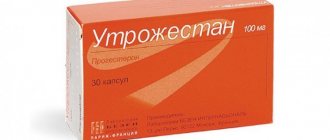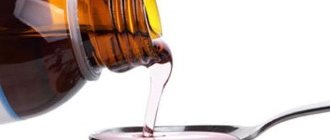Grinterol®
Children and adults weighing less than 47 kg are recommended to use ursodeoxycholic acid in suspension.
Dissolution of cholesterol gallstones
The recommended dose is 10 mg of ursodeoxycholic acid per 1 kg of body weight per day, which corresponds to:
| Body mass | Number of capsules |
| Up to 60 kg | 2 |
| 61-80 kg | 3 |
| 81-100 kg | 4 |
| Over 100 kg | 5 |
The drug must be taken daily in the evening, before bed (the capsules are not chewed), with a small amount of liquid.
Duration of treatment is 6-12 months. To prevent recurrent cholelithiasis, it is recommended to take the drug for several months after the stones have dissolved.
Treatment of biliary reflux gastritis
1 capsule of GRINTEROL® daily in the evening before bed, without chewing and with a small amount of water.
The course of treatment is from 10-14 days to 6 months, if necessary - up to 2 years.
Treatment of primary biliary cirrhosis
The daily dose depends on body weight and ranges from 3 to 7 capsules (approximately 14 ± 2 mg ursodeoxycholic acid per 1 kg of body weight).
In the first 3 months of treatment, taking GRINTEROL® capsules 250 mg should be divided into several doses throughout the day. After improvement of liver parameters, the daily dose can be taken once in the evening.
The following mode of application is recommended:
250 mg capsules
| Body mass | GRINTEROL® capsules 250 mg | |||
| First 3 months of treatment | Subsequently | |||
| Morning | Day | Evening | Evening (1 time per day) | |
| 47-62 kg | 1 | 1 | 1 | 3 |
| 63-78 kg | 1 | 1 | 2 | 4 |
| 79-93 kg | 1 | 2 | 2 | 5 |
| 94-109 kg | 2 | 2 | 2 | 6 |
| Over 110 kg | 2 | 2 | 3 | 7 |
Capsules should be taken regularly, without chewing, with a small amount of liquid.
The use of ursodeoxycholic acid for the treatment of primary biliary cirrhosis can be continued indefinitely.
In patients with primary biliary cirrhosis, in rare cases, clinical symptoms may worsen at the beginning of treatment, for example, itching may become more frequent. In this case, treatment should be continued, taking one capsule daily, then the dosage should be gradually increased, increasing the daily dose by one capsule weekly, until the recommended dosage regimen is achieved again.
Symptomatic treatment of chronic hepatitis of various origins
- daily dose 10-15 mg/kg in 2-3 doses. Duration of treatment is 6-12 months or more.
Primary sclerosing cholangitis
— daily dose 12-15 mg/kg; if necessary, the dose can be increased to 20-30 mg/kg in 2-3 doses. The duration of therapy ranges from 6 months to several years (see section “Special instructions”).
Cystic fibrosis (cystic fibrosis) -
daily dose 20 mg/kg/day in 2-3 divided doses, with a further increase to 30 mg/kg/day if necessary.
| Body weight (kg) | Daily dose (mg/kg body weight) | GRINTEROL ® capsules 250 mg | ||
| Morning | Day | Evening | ||
| 20-29 | 17-25 | 1 | — | 1 |
| 30-39 | 19-25 | 1 | 1 | 1 |
| 40-49 | 20-25 | 1 | 1 | 2 |
| 50-59 | 21-25 | 1 | 2 | 2 |
| 60-69 | 22-25 | 2 | 2 | 2 |
| 70-79 | 22-25 | 2 | 2 | 3 |
| 80-89 | 22-25 | 2 | 3 | 3 |
| 90-99 | 23-25 | 3 | 3 | 3 |
| 100-109 | 23-25 | 3 | 3 | 4 |
| >110 | 3 | 4 | 4 | |
Non-alcoholic steatohepatitis -
the average daily dose is 10-15 mg/kg in 2-3 doses. The duration of therapy ranges from 6-12 months or more.
Alcoholic liver disease
- average daily dose 10-15 mg/kg in 2-3 doses. The duration of therapy ranges from 6-12 months or more.
Biliary dyskinesia -
the average daily dose is 10 mg/kg in 2 divided doses for 2 weeks to 2 months. If necessary, it is recommended to repeat the course of treatment.
Grinterol instructions for use
INSTRUCTIONS for medical use of the drug Grinterol
Registration certificate holder: GRINDEX, JSC (Latvia) Representative office: GRINDEX JSC (Latvia)
ATX code: A05AA02 (Ursodeoxycholic acid)
Active substance: ursodeoxycholic acid
Dosage form caps. 250 mg: 50 or 100 pcs.
Release form, composition and packaging Hard gelatin capsules, No. 0, white body and cap; contents : white or almost white powder. 1 caps. ursodeoxycholic acid 250 mg Excipients: corn starch - 73.0 mg, silicon dioxide - 5.0 mg, magnesium stearate - 2.0 mg. Composition of the capsule shell (body and cap): titanium dioxide (E 171) - 2%, gelatin - up to 100%. 10 pieces. — contour cell packaging (5) — cardboard packs. 10 pieces. — contour cell packaging (10) — cardboard packs.
Clinical and pharmacological groups Drug that promotes the dissolution of cholesterol gallstones Hepatoprotector
Pharmacotherapeutic group: Hepatoprotective agent
Pharmacological action Pharmacokinetics Indications - dissolution of small and medium-sized cholesterol stones with a functioning gall bladder; - biliary reflux gastritis; - primary biliary cirrhosis in the absence of signs of decompensation (symptomatic therapy); — chronic hepatitis of various origins; - primary sclerosing cholangitis; - cystic fibrosis (cystic fibrosis); - non-alcoholic steatohepatitis; - alcoholic liver disease (ALD); - biliary dyskinesia.
Dosage regimen: Inside. Capsules are taken in the evening, without chewing, with a small amount of water. Dissolution of cholesterol gallstones: average daily dose – 10 mg/kg, which corresponds to: Body weight (kg) Number of capsules Up to 60 2 61-80 3 81-100 4 Over 100 5 Course of treatment – 6-12 months. To prevent the re-formation of stones, it is recommended to take the drug for several more months after the stones have dissolved. Treatment of biliary reflux gastritis: one capsule 250 mg 1 time per day in the evening. The course of treatment is from 10-14 days to 6 months, if necessary – up to 2 years. Symptomatic treatment of primary biliary cirrhosis in the absence of signs of decompensation: 10-15 mg/kg (if necessary, up to 20 mg/kg) per day in 2-3 doses in the first 3 months of treatment. After improvement of liver parameters, the daily dose can be administered once in the evening.
The following regimen is recommended: Body weight (kg) Daily dose (number of capsules) Morning Afternoon Evening 47-62 3 1 1 1 63-78 4 1 1 2 79-93 5 1 2 2 94-109 6 2 2 2 Over 100 7 2 2 3 The duration of treatment is unlimited. In rare cases, at the beginning of treatment, clinical symptoms may worsen (itching may become more frequent). In this case, you should take one capsule daily, then gradually increase the dosage (increasing the daily dose by one capsule weekly) until the recommended dosage regimen is achieved. Symptomatic treatment of chronic hepatitis of various origins: daily dose is 10-15 mg/kg in 2-3 doses. Duration of treatment is 6-12 months or more. Primary sclerosing cholangitis: 12-15 mg/kg (up to 20 mg/kg) body weight per day in 2-3 divided doses. Duration of use – from 6 months to several years. Cystic fibrosis (cystic fibrosis): 20-30 mg/kg per day in 2-3 doses. Duration of use – from 6 months to several years. Non-alcoholic steatohepatitis: the average daily dose is 10-15 mg/kg in 2-3 doses. Duration of use – from 6-12 months or more. Children over 3 years of age are prescribed individually at a rate of 10-20 mg/kg per day. Alcoholic liver disease: average daily dose – 10-15 mg/kg in 2-3 doses. The duration of therapy is 6-12 months or more. Biliary dyskinesia: average daily dose of 10 mg/kg in 2 divided doses for 2 weeks to 2 months. If necessary, it is recommended to repeat the course of treatment. Children and adults weighing less than 47 kg are recommended to use the drug in suspension from other manufacturers.
Side effects : Gastrointestinal disorders: loose stools or diarrhea. When treating primary biliary cirrhosis, acute pain in the right upper abdomen may occur. Disorders of the liver and biliary tract: calcification of gallstones. During the treatment of primary biliary cirrhosis, transient decompensation of liver cirrhosis may occur (resolves after discontinuation of the drug). Disorders of the skin and subcutaneous tissues: allergic reactions (including urticaria).
Contraindications for use : hypersensitivity to the components of the drug; — X-ray positive (high Ca2+ content) gallstones; - non-functioning gallbladder; - acute inflammatory diseases of the gallbladder, bile ducts and intestines; — liver cirrhosis in the stage of decompensation; - severe liver and/or kidney failure; - pancreatitis; - children under 3 years of age (for capsules).
With caution: children aged 3 to 4 years should use with caution, as it may be difficult to swallow the capsules. Use during pregnancy and breastfeeding Animal studies have not revealed mutagenic or carcinogenic effects, however, due to the lack of clinical studies on pregnant women, use during pregnancy is possible only if the expected benefit to the mother outweighs the potential risk to the fetus. There are no data on excretion in breast milk, therefore, if use during lactation is necessary, breastfeeding should be avoided.
Special instructions Treatment should be carried out under the supervision of a physician. When prescribed for the purpose of dissolving gallstones, it is necessary to control the activity of “liver” transaminases and silk phosphatase, gamma-glutamyl transpeptidase, and bilirubin concentration. Cholecystography should be performed every 4 weeks in the first 3 months of treatment, then every 3 months. The effectiveness of treatment is monitored every 6 months during an ultrasound examination during the first year of therapy. If elevated levels persist, the drug should be discontinued. For successful dissolution, it is necessary that the stones are purely cholesterol, no more than 15-20 mm in size, the gallbladder is no more than half filled with stones, and the bile ducts fully retain their function. After complete dissolution of the stones, it is recommended to continue use for at least 3 months in order to promote the dissolution of stone remains that are too small to be detected. If partial dissolution of the stones has not occurred within 6-12 months after the start of therapy, it is unlikely that the treatment will be effective. The discovery of a non-visualized gallbladder during treatment is evidence that complete dissolution of the stones has not occurred and treatment should be stopped. In patients with diarrhea, the dosage of ursodeoxycholic acid should be reduced. If diarrhea persists, treatment should be discontinued. Long-term therapy with high doses of ursodeoxycholic acid (28-30 mg/kg/day) can lead to the development of serious side effects in patients with primary sclerosing cholangitis.
Effect on the ability to drive vehicles and machinery. No impact on the ability to drive vehicles or machinery has been identified.
Overdose There are no known cases of overdose of ursodeoxycholic acid.
Drug interactions Antacids containing aluminum hydroxide, aluminum oxide and ion exchange resins (colestyramine, colestipol) reduce the absorption of ursodeoxycholic acid in the intestine, thus reducing its effectiveness; therefore, the listed drugs should be used 2 hours before taking ursodeoxycholic acid. Ursodeoxycholic acid may enhance the absorption of cyclosporine from the intestine, so the dose of cyclosporine should be adjusted if used concomitantly. Ursodeoxycholic acid may reduce the absorption of ciprofloxacin. Lipid-lowering drugs (especially clofibrate), estrogens, neomycin or progestins, and oral contraceptives increase the saturation of bile with cholesterol and may reduce the ability to dissolve cholesterol gallstones.
Conditions for dispensing from pharmacies By prescription.
Storage conditions and periods Store at a temperature not exceeding 25 ºС. Keep out of the reach of children.
Shelf life : 2 years. Do not use after the expiration date stated on the package.
Ursodesoxycholic acid
Inside.
Children and adults weighing less than 47 kg are recommended to use ursodeoxycholic acid in suspension.
Dissolution of cholesterol gallstones
The recommended dose is 10 mg of ursodeoxycholic acid per 1 kg of body weight per day, which corresponds to:
| Body weight, kg | Number of capsules, pcs. |
| Up to 60 | 2 |
| 61-80 | 3 |
| 81-100 | 4 |
| Over 100 | 5 |
The drug must be taken daily in the evening, before bed (the capsules are not chewed), with a small amount of water.
Duration of treatment is 6-12 months. To prevent recurrent cholelithiasis, it is recommended to take the drug for several months after the stones have dissolved.
If after 12 months of treatment the size of the stones does not decrease, then treatment should be stopped. The effectiveness of treatment should be assessed every 6 months with ultrasound or radiography. During the interim examination, it is necessary to assess whether calcification of the stones has occurred during the intervening period. In case of calcification of stones, treatment should be discontinued.
Treatment of biliary reflux gastritis
1 capsule of ursodeoxycholic acid daily in the evening before bed, without chewing and with a small amount of water.
The course of treatment is from 10-14 days to 6 months, if necessary - up to 2 years.
Treatment of primary biliary cirrhosis
The daily dose depends on body weight and ranges from 3 to 7 capsules (approximately 14 ± 2 mg ursodeoxycholic acid per 1 kg of body weight).
In the first 3 months of treatment, the daily dose of ursodeoxycholic acid should be divided into several doses throughout the day. After improving the functional parameters of the liver, you can switch to a single daily dose of the drug in the evening. The following mode of application is recommended:
250 mg capsules
| Body weight, kg | First 3 months of treatment | Subsequently | ||
| Morning | Day | Evening | Evening (1 time per day) | |
| 47-62 | 1 | 1 | 1 | 3 |
| 63-78 | 1 | 1 | 2 | 4 |
| 79-93 | 1 | 2 | 2 | 5 |
| 94-109 | 2 | 2 | 2 | 6 |
| Over 110 | 2 | 2 | 3 | 7 |
Capsules should be taken regularly, without chewing, with a small amount of water.
The use of ursodeoxycholic acid for the treatment of primary biliary cirrhosis can be continued indefinitely.
In patients with primary biliary cirrhosis, in rare cases, clinical symptoms may worsen at the beginning of treatment, for example, itching may become more frequent. In this case, treatment should be continued, taking 1 capsule daily, then the dose should be gradually increased, increasing the daily dose by 1 capsule weekly, until the recommended dosage regimen is achieved again.
Symptomatic treatment of chronic hepatitis of various origins is a daily dose of 10-15 mg/kg in 2-3 doses. Duration of treatment is 6-12 months or more.
Primary sclerosing cholangitis - daily dose 12-15 mg/kg; if necessary, the dose can be increased to 20-30 mg/kg in 2-3 doses. The duration of therapy ranges from 6 months to several years (see section “Special instructions”),
Cystic fibrosis (cystic fibrosis) - daily dose of 20 mg/kg/day in 2-3 doses, with a further increase to 30 mg/kg/day if necessary.
250 mg capsules
| Body weight (kg) | Daily dose (mg/kg body weight) | Morning | Day | Evening |
| 20-29 | 17-25 | 1 | — | 1 |
| 30-39 | 19-25 | 1 | 1 | 1 |
| 40-49 | 20-25 | 1 | 1 | 2 |
| 50-59 | 21-25 | 1 | 2 | 2 |
| 60-69 | 22-25 | 2 | 2 | 2 |
| 70-79 | 22-25 | 2 | 2 | 3 |
| 80-89 | 22-25 | 2 | 3 | 3 |
| 90-99 | 23-25 | 3 | 3 | 3 |
| 100-109 | 23-25 | 3 | 3 | 4 |
| >110 | 3 | 4 | 4 |
Non-alcoholic steatohepatitis - average daily dose of 10-15 mg/kg in 2-3 doses. The duration of therapy ranges from 6-12 months or more.
Alcoholic liver disease - average daily dose of 10-15 mg/kg in 2-3 doses. The duration of therapy ranges from 6-12 months or more.
Biliary dyskinesia - average daily dose of 10 mg/kg in 2 divided doses for 2 weeks to 2 months. If necessary, it is recommended to repeat the course of treatment.



